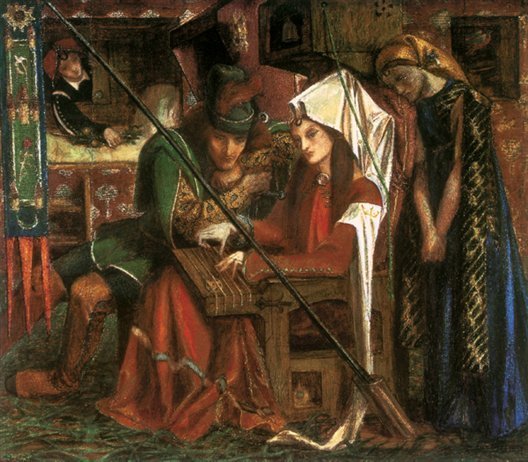
Dante Gabriel Rossetti,
The Tune of the Seven Towers, 1857.
Watercolour on paper, 31.4 x 36.5 cm.
Tate Britain, London.
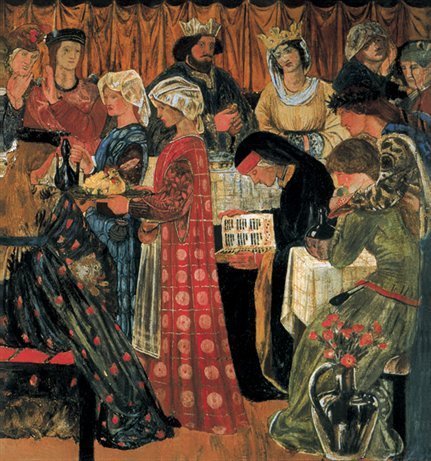
Edward Burne-Jones,
Wedding Banquet of Sire Devrevaunt, 1860.
One of three murals for the Red House
reception hall. Victoria & Albert Museum, London.
When one walks through the Umbrian room in the National Gallery, one sees a small painting made by Raphael when he was seventeen years old, The Knight’s Dream. A young lord, dressed in armour, has fallen asleep against a shadowless laurel tree; to his left and right stand two differently dressed women. One holds out a book and an unsheathed sword, the other a flowering sprig of myrtle. The first is duty, and the second is pleasure. The handsome adolescent, at the verge of crossing the threshold into his adult life, has stopped here to sleep. He sleeps gracefully and happily on this old shield that whispers battle hymns in his ear. The two women’s arms hold their gifts out toward him, tirelessly, as if they were two tree branches, each holding one beautiful ripe fruit. These two figures are so tempting that perhaps the clever youth would like to keep one without losing the other, to follow both of them at once, and in his state of indecision, in his unwillingness to make a choice, in order to give himself a bit more time, he does not wake, thinking that as long as they see him sleep, these two goddesses will not leave. And for four hundred years he has slept, still tempted, still undecided, and Raphael’s knight will now probably never awaken. However, in the background shine beautiful blue horizons where one would love to walk with one’s joys and sorrows, far from space and time, breathing the eternal atmosphere that, in works of art, bathes the figures that a painter who lived but a day has created.
Every young, restless artist who is looking for new paths to follow, who goes to England and falls into a daydream while looking at Briar-Rose or Love and Death, resembles this sleeping knight. Not in the sense that he is caught between good and evil, between duty and pleasure, but in the sense that two forms of art call to him, and these are but divinities or illusions in a dream. On one side, Burne-Jones’s nymph offers him the myrtle of legend, and on the other, Watts’ virtue offers the naked sword of morality. If he follows either of them, he will certainly be lost. May he look instead to the background, to those winding paths, curving valleys, blue-tinged mountains, and flowing waters. May he return now and always to nature, the only counsel that one may listen to without suspicion, the only enchantress that one may follow without remorse. The English painters were great tempters; let us admire them, not imitate them.
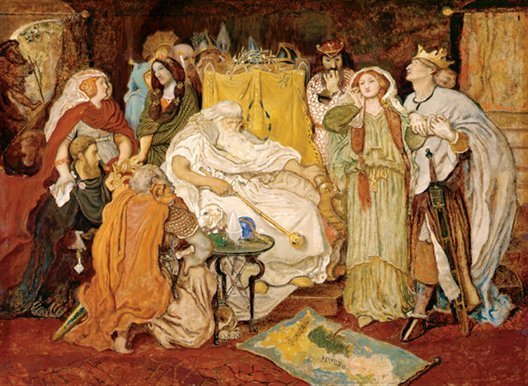
Ford Madox Brown,
Cordelia’s Potion, 1867-1875.
Oil on canvas, 55.9 x 77.2 cm.
The Fitzwilliam Museum, Cambridge.
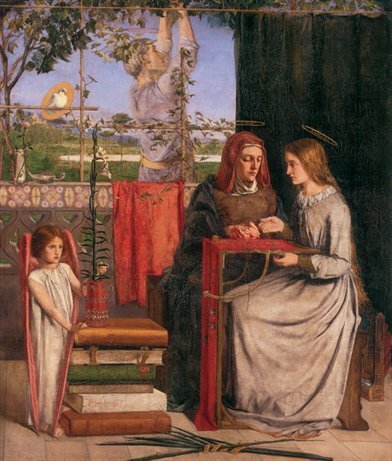
Dante Gabriel Rossetti,
The Girlhood of Mary Virgin, 1848-1849.
Oil on canvas, 83.2 x 65.4 cm.
Tate Britain, London.
Major Artists
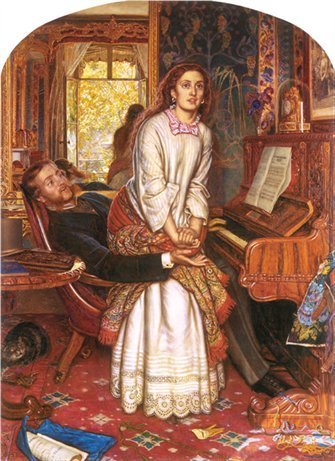
William Holman Hunt,
The Awakening Conscience, 1853.
Oil on canvas, 76.2 x 55.9 cm.
Tate Britain, London.
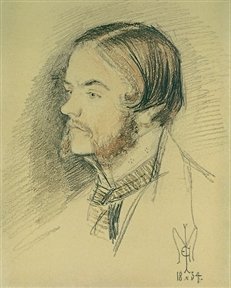
John Everett Millais,
William Holman Hunt, 1854.
Pencil and watercolour, 20.3 x 17.8 cm.
The Ashmolean Museum of Art and Archaeology,
University of Oxford, Oxford.
William Holman Hunt
(London, 1827 - London, 1910)
William Holman Hunt came from an impoverished family and did not enjoy the same material comfort and encouragement as Rossetti and Millais. One of his paternal ancestors had left England to fight for the Protestant cause, returning with William of Orange but never regaining his property. Hunt’s father found himself working as the administrator of a municipal warehouse, with tastes above those typical of his social standing. He loved books and images and encouraged his son to follow art as a hobby, but not as a profession. At twelve years of age, Holman Hunt worked as an office employee but devoted his free time to reading, drawing and painting, and at sixteen he began his career as an independent artist. In 1844 he entered the Royal Academy, where he met John Everett Millais, who was around fifteen years old at the time. He began exhibiting his work in 1845 at the Royal Manchester Institution and in 1846 at the Royal Academy and the British Institution. In 1848, Hunt and Millais, along with Rossetti, initiated the Pre-Raphaelite movement and Hunt subsequently painted Rienzi vowing to obtain Justice, a good example of their new principles. In 1850, the painting A Converted Christian Family sheltering a Missionary was sold to Thomas Combe, who became his patron, friend, and adviser. Additionally, this scene taken from the Two Gentlemen of Verona was praised highly by Ruskin in his letters to The Times. He declared that there had been nothing like this study of draperies and details since Albrecht Dürer. The painting won a prize in Liverpool and is considered to be one of the most beautiful works of Hunt’s youth. In 1852 he exhibited The Hireling Shepherd, Claudio and Isabella, and The Unwatched Flock (at the time called Our English Coasts). For three of his works, Hunt had obtained £50 and £60 in Liverpool and Birmingham, but in 1851, he was so discouraged by the declining sales of his paintings that he decided to abandon art and devote himself to agriculture, intending to emigrate. In 1854, however, he achieved his first great success with the painting The Light of the World, an allegorical representation of Christ knocking at the door of the human soul. This painting made a great impression on Hunt’s contemporaries. The Awakening Conscience appeared at the same time and depicted a tragic moment in which a girl leading a life of sin is struck by the memory of her innocent childhood and stands up suddenly from the knees of her lover.
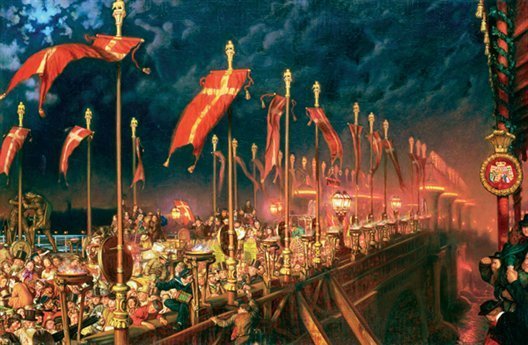
William Holman Hunt,
London Bridge on the Night of the Marriage
of the Prince and Princess of Wales, 1863-1866.
Oil on canvas, 65 x 98 cm.
The Ashmolean Museum of Art and Archaeology,
University of Oxford, Oxford.
In January of 1854, Holman Hunt left England for Syria and Palestine, driven by the desire to depict the story of the Scriptures through painting, “immersed in the people and the conditions of life of ancient Judaea.” The first product of this idea was The Scapegoat, a rejected and solitary animal on the salt-encrusted banks of the Dead Sea, with the Edom Mountains in the background. This painting was exhibited at the Royal Academy in 1856, with three landscapes of the Middle East. In 1857 he collaborated with Moxon in publishing the poems of Alfred Tennyson. His 1860 painting Christ in the Temple was one of his most elaborate and admired works. Like all his important paintings, it was the fruit of years of work. The work was difficult to complete; a series of obstacles considerably slowed its execution, including a sentence akin to excommunication for all of the Jews who posed for it (the sentence was later lifted). This painting, exhibited in London and many provincial towns, attracted crowds.